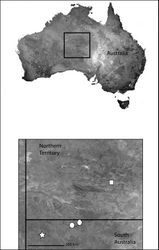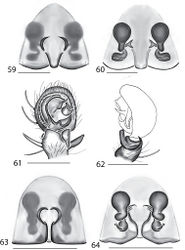Karaops deserticola
| Notice: | This page is derived from the original publication listed below, whose author(s) should always be credited. Further contributors may edit and improve the content of this page and, consequently, need to be credited as well (see page history). Any assessment of factual correctness requires a careful review of the original article as well as of subsequent contributions.
If you are uncertain whether your planned contribution is correct or not, we suggest that you use the associated discussion page instead of editing the page directly. This page should be cited as follows (rationale):
Citation formats to copy and paste
BibTeX: @article{Crews2011ZooKeys99, RIS/ Endnote: TY - JOUR Wikipedia/ Citizendium: <ref name="Crews2011ZooKeys99">{{Citation See also the citation download page at the journal. |
Ordo: Araneae
Familia: Selenopidae
Genus: Karaops
Name
Karaops deserticola Crews & Harvey, 2011 sp. n. – Wikispecies link – ZooBank link – Pensoft Profile
Type material
Holotype female (SAM N199350): Mount Lindsay, South Australia, Australia [27°02'S, 129°53'E], 28.VIII.1980, A. Lees, under rock slab on bare granite slope.
Etymology
The specific epithet comes from the Latin word desertum which is a waste place or a wilderness and is an adjective that denotes the presence of this species in desert biotopes.
Diagnosis
Females can be differentiated from other species by the median septum of the copulatory organs tapering posteriorly, giving it a subtriangular appearance (Fig. 59). Males unknown.
Description
Holotype:Color: carapace yellow-brown, with slightly darker marks medially; sternum pale yellow-brown; chelicerae pale yellow with darker infuscations anteriorly; maxillae pale yellow-brown; labium pale yellow-brown; abdomen dorsally yellow-brown with red-brown and grey markings; ventrally pale yellow-brown; legs with segments clearly annulated, but annulations do not completely encircle femorae, legs darkening distally at tibiae; annulations lighter in centers giving a ‘leopard spot’ appearance. Cephalothorax:setae short, stout, rodlike; 0.85 times longer than broad; fovea longitudinal, broad, very shallow. Eyes:AER nearly straight; PER recurved; PME larger than AME, PLE largest, ALE smallest; eye group width 1.64; eye diameters, AME 0.17, ALE 0.12, PME 0.23, PLE 0.34; interdistances AME-ALE 0.30, PME-PLE 0.27, ALE-PLE 0.18, AME-PME 0.06; ocular quadrangle AME-AME 0.48, PME-PME 0.92; clypeus 0.15 high. Mouthparts:chelicerae with a few stout setae medially and anteriorly; lateral boss present, smooth; promargin with 3 teeth, retromargin with 2 teeth; maxillae longer than broad, with tuft of conspicuous setae distally; labium distally rounded. Sternum:0.84 times longer than broad, posteriorly indented. Pedipalp:tarsus slightly swollen, claw present, without teeth. Legs:leg I only slightly shorter than legs II, III; leg III longest; scopulae absent on all legs; tarsus I–IV with strong claw tufts; claws prolateral claw with 1 or 2 small teeth; spination: leg I, Fm pr 1–1–0, d 1–1–1, rl 0; Ti d 0, v 2–2–2–2–2; Mt v 2–2–2; Ti and Mt I and II with strong spines; leg II, Fm pr 0, d 1–1–1, rl 0; Ti v 2–2–2–2–2; Mt v 2–2–2; leg III, Fm pr 0, d 1–1–1, rl 0; Ti 0; Mt 0; leg IV, Fm pr 0, d 1–1–1, rl 0; Ti 0; Mt 0. Abdomen:possible setal tufts, hairs worn off. Epigyne:lateral lobes surround triangular median area, two parentheses-like marks located in the center of the plate, strongly sclerotized, copulatory openings located under these, epigynal pockets absent; internally, short ducts lead to round, well separated spermathecae, copulatory ducts twist posteriorly to fertilization ducts, posterodorsal fold absent (Figs 59–60). Dimensions: Total length 5.72. Cephalothorax length 2.91, width 3.44. Sternum length 1.51, width 1.79. Abdomen length 2.91, width 2.75. Pedipalp: Fm 0.77, Pt 0.57, Ti 0.48, Ta 0.77, (total) 2.59. Leg I: Fm 3.37, Pt 1.46, Ti 2.96, Mt 1.81, Ta 1.14, (total) 10.74. Leg II: Fm 3.88, Pt 1.48, Ti 2.96, Mt 2.77, Ta 1.18, (total) 12.27. Leg III: F 4.44, Pt 1.63, Ti 3.51, Mt 3.04, tarsus 1.17, (total) 13.79. Leg IV: Missing.
Natural history
Collected from under rocks.
Distribution
The type locality only (Map 9).
Original Description
- Crews, S; Harvey, M; 2011: The spider family Selenopidae (Arachnida, Araneae) in Australasia and the Oriental Region ZooKeys, 99: 1-104. doi
Images
|

